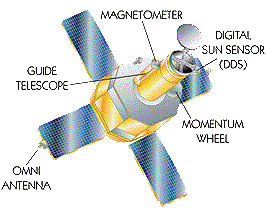 Every eleven years, the surface of the Sun is disrupted from inside by massive ruptures, known as flares. Scientists want to know more about those enormous solar outbursts because they have the potential to threaten astronauts in space stations and disrupt satellites used for critical national security, weather forecasting, navigation and communications functions.
Every eleven years, the surface of the Sun is disrupted from inside by massive ruptures, known as flares. Scientists want to know more about those enormous solar outbursts because they have the potential to threaten astronauts in space stations and disrupt satellites used for critical national security, weather forecasting, navigation and communications functions.With one of those intense periods of solar eruptions underway now, NASA has launched a satellite to Earth orbit to be on the lookout for big upheavals on the Sun. Named TRACE, for Transition Region and Coronal Explorer, the 469-lb. satellite was launched from Vandenberg Air Force Base in California in April 1998 on a one-year mission to observe the Sun and study the complete range of solar conditions, including the connection between the Sun's magnetic fields and the heating of its corona.
The computerized satellite was lofted to space on a Pegasus XL rocket dropped from a jet airplane flying at 39,000 ft. over the Pacific Ocean off the California coast. The satellite is in an orbit ranging from 325-342 miles in altitude.
TRACE's main instrument is a Cassegrain telescope which is 30 cm. in diameter and 160 cm. long. It has an 8.66 m. focal length. It will be used to explore the three-dimensional magnetic structures that emerge through the photosphere, the visible surface of the Sun, through the upper solar atmosphere -- the Transition Region and Corona. The photosphere temperature is 6000 degrees K., while the corona is at ten million degrees.
Small Explorer Satellites
TRACE is one of several small satellites in NASA's Small Explorer (SMEX) project managed by Goddard Space Flight Center, Greenbelt, Maryland, for NASA's Office of Space Science, Washington, D.C. NASA is the National Aeronautics and Space Administration.
The SMEX satellites are:
- SAMPEX, the Solar Anomalous and Magnetospheric Particle Explorer, launched by a Scout rocket in 1992. It is investigating the composition of local interstellar matter and solar material and the transport of magnetospheric charged particles into the Earth's atmosphere.
- FAST, the Fast Auroral Snapshot Explorer, launched in 1996 aboard a Pegasus XL rocket. FAST is probing the physical processes that produce aurorae, the displays of light that appear in Earth's upper atmosphere at high latitudes.
- TRACE, the Transition Region and Coronal Explorer, launched in 1998 aboard a Pegasus XL rocket. It is observing the Sun for the connection between its magnetic fields and the heating of the Sun's corona.
- SWAS, the Submillimeter Wave Astronomy Satellite, to be launched in 1999 aboard a Pegasus XL rocket. SWAS will, for the first time by direct observation, measure the amount of water and molecular oxygen in interstellar clouds. SWAS also will measure carbon monoxide and atomic carbon, which are believed to be major reservoirs of carbon in these clouds.
- WIRE, the Wide-Field Infrared Explorer, to be launched in 1998-99. It will use a cryogenically-cooled telescope and arrays of highly sensitive infrared detectors for the study of galaxy evolution.
- SMEX-Lite, an all-new system for the future intended to provide ultra-low-cost small spacecraft with performance that exceeds the initial five SMEX Missions.
To learn more:
- Learn more about TRACE from NASA's Project Goddard Space Flight Center
Learn more about SMEX satellites from NASA's Project Goddard Space Flight Center
| Inner Planets: | Mercury | Venus | Earth | Mars | |
| Outer Planets: | Jupiter | Saturn | Uranus | Neptune | Pluto |
| Other Bodies: | Moons | Asteroids | Comets | The Voyagers | |
| Solar System index | STO Cover | Search STO | Questions |
| Top of this page | About STO | Feedback |
© 2002 Space Today Online